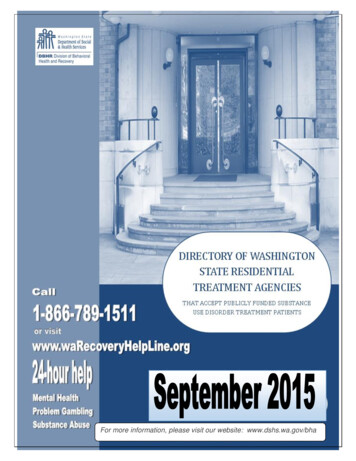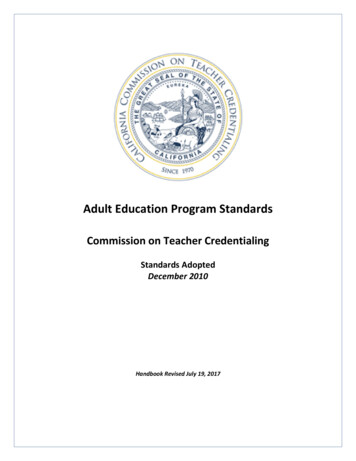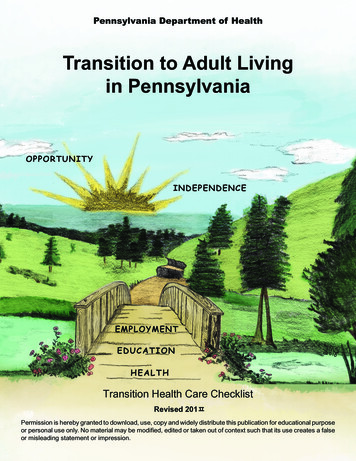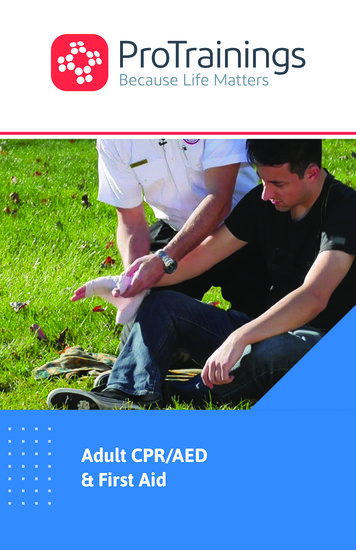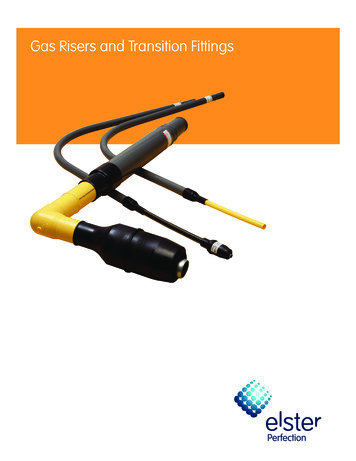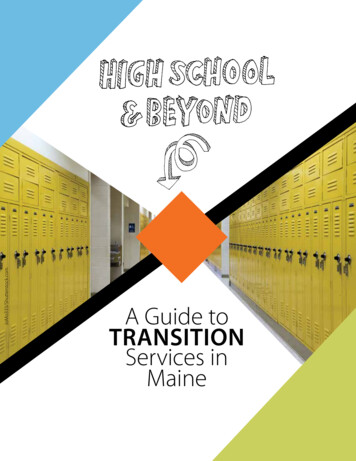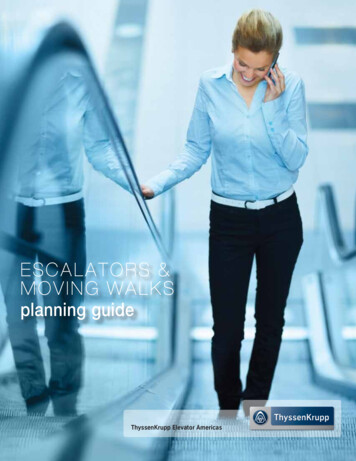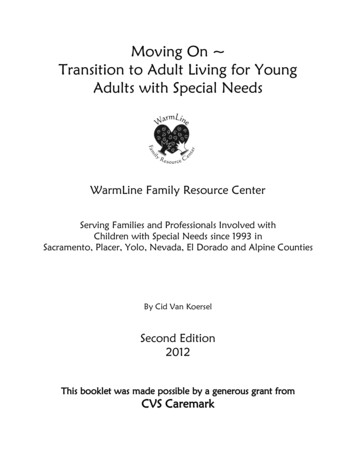
Transcription
Moving On Transition to Adult Living for YoungAdults with Special NeedsWarmLine Family Resource CenterServing Families and Professionals Involved withChildren with Special Needs since 1993 inSacramento, Placer, Yolo, Nevada, El Dorado and Alpine CountiesBy Cid Van KoerselSecond Edition2012This booklet was made possible by a generous grant fromCVS Caremark
What Is WarmLine Family Resource Center? “My teen with special needs is leaving high school and I don’t know where he’ll live orwhat kind of work he’ll be able to get. Do you know who I can call?” “My two year old needs a daycare program. No one I’ve talked with will even considerher because she has special needs. Can you help?” “My daughter is pregnant with our first grandchild and just found out that the baby will beborn with Down syndrome. Can you give us some information and tell us where to find support?” “I have a client whose two year old has recently been diagnosed with a developmental delay. They really need to connect with another family. The stress of dealing with this is reallyhard on them.”WarmLine is an information and support center for parents and professionals involved with children with special health care or developmental needs. We receive calls fromboth parents and professionals regarding a wide variety of issues, needs and services such ashealth care, child care and special education.WarmLine Family Resource Center can make a difference in the lives of families weserve. Family time may be hampered by the stress and demands of locating appropriate services. We link callers with resources - often saving them hours of research and frustration.Our services include: Linking families with services through information and referral. Providing family support through playgroups, family activities and parent education. Strengthening parents’ knowledge and decision-making abilities. Training parents and professionals about child development. A resource library and publications available from WarmLine or on our website. Community Resource Parents — Local representatives in each county. Increasing public awareness of disabilities and available services through outreach activities.Information is empowering. People going into a situation well prepared have a betterchance of knowing that they have given it their best. WarmLine seeks to inform and supportparents and professionals in any way we can.Sacramento: 916-922-9276 / 800-660-7995 (Spanish: 916-922-1490)Placer County: 916-632-2100i
Table of ContentsFrom the Author . ivIntroduction. vSection OnePreparing for the Future . 2Self-Determination/Self-Advocacy . 2Transition Services in High School (IEP) . 4Student-Led IEPs. 5Vocational/Employment Programs (IEP). 6California High School Exit Examination . 6Alta California Regional Center . 716 Tips for Getting Quality Regional Center Services . 8Helping Your Teen to Independence . 10Exploring Options for the Future . 11Secondary Education. 12Day Programs . 13Paid Employment . 14Supported Employment . 14Living Options . 14Financial AssistanceSSI . 17IHSS. 18Transitioning to Adult Medical Care. 18Resources for Health Care ServicesAccess for Infants and Mothers (AIM) . 21California Children’s Services (CCS) . 22Genetically Handicapped Person Program . 23Medi-Cal . 23Dental Health Services . 23Hearing Aids . 25Eye Glasses . 25Mental Health Services . 25Planned Parenthood . 25County Primary Health Services . 26Medication Assistance . 26ii
Safety Skills . 26Sexuality . 27Friends & Relationships/Recreation . 29Service Dogs . 29Conservatorship . 30Power of Attorney . 35Estate Planning. 35Adapting Your Home for an Adult with a Disability . 36Voter Registration . 37Selective Service Registration . 37Disabled Parking Placard . 38Driver’s License . 39California ID Card. 39Public Transportation . 40Utilities . 41California Telephone Access Program . 42California Lifeline Program . 43Section TwoStudent’s Guide to the IEP . 45My Transition Plans/Goals . 52Questions to Ask When Touring a Day Program . 55Questions to Ask When Touring a Group Home . 59Questions to Ask a Supported Living Agency . 61Independent Living Skills Checklist . 63My Social Support System . 66Resources for Parents of Teens with Special Needs . 67Notes. 70iii
From the author This booklet is broken up into two sections. The first section focusesself-advocacy, special education requirements, programs, services andresources for teens and young adults.The second section contains a check list to help parents and teensidentify the skills needed for independence, questions to ask whentouring day programs and group homes and guidelines to help teensparticipate in their IEPs and IPPs.For convenience, the pronouns; he/she, etc. have been used interchangeably.The term “service partners” has been used rather than “service providers” because everyone who works with our children should think ofthemselves as partners with parents and the children in the goal of encouraging a meaningful life and independence.Deepest thanks to the many parents and professionals who contributed to this booklet. Your input has been invaluable!Thanks most of all to our children.you’re the lights of our lives andour fondest wish for you is that you are able to spread your wings andfly!CVKiv
Introduction – A Note to Parents and GuardiansMany parents of young adults with special needs say, “If I only knew then what Iknow now ” This booklet contains information that some of those parents say theywish they had known.Transition involves moving from one place, stage or relationship to another. Transitions happen throughout every person’s lifetime. Change can be stressful, but with preparation, support, information, and planning, transition to adult programs and services canbe made easier for you and your teen.Children with special needs (and their families) may experience more frequent andsome times more challenging transitions than do typical families such as changes of teachers, therapists, case managers, etc. who might have been involved with the family foryears and who might seem part of the family. You, the parent, are the constant in yourchild’s life and provide the link between your teen and all of the various services, programs, and people who have provided those services in the past and who will providethose services in the future. Your knowledge of the needs of your family and teen canhelp her transition(s) to be successful and we hope you use this workbook as a tool forthat success.“One of the most striking (and most stressful) aspects of transition for families ofchildren with exceptional needs is that it focuses on relationships: beginning and endingthem, leaving a comfortable situation and starting all over again.”Brekken & Knowlton, Transition Issues: A Model for Early Childhood Special EducationThis booklet has been prepared for you by WarmLine Family Resource Center tohelp you and your teen prepare for transition from high school into the adult world. Students receiving special education generally face several changes in their programs betweenthe age of 18 and 22 and most parents who have been through the process agree that theearlier you and your teen start exploring options, the better.The passage of your teen into adulthood is an exciting time, but can alsobe worrisome as you face a range of options, services and providers that are newto you. “Moving On” does not contain every resource possibles, but was writtento give you as much information in a “one stop” format as possible. Good luck toyou and your teen as you travel this wonderful road of growth and discovery intoadulthood.This booklet was made possible through a generous grant fromCVS Caremark.v
SectionOne1
“My son is now 21 years old and I feel as though I’ve been in denial about what types ofprograms I should have been looking for when he was a teen. I wish that when he was youngerI had known what questions to ask. Now I feel like I’m playing ‘”catch up”.Preparing for the FuturePreparing for your teen’s transition to the adult world should not be put off untilage 16, when it must be addressed in the IEP or at 18, when he has become an adult.Talking and thinking about future plans should start when all children are very young.When typically developing children are young, as parent we ask them what they“want to be when they grow up”. We expect their goals to change and evolve overtime. We know that it’s O.K. for a five year old child to want to be an astronaut, at tena chef and at 15, a veterinarian. Unfortunately, children with disabilities are not askedthis question as frequently they’re not as likely to be urged to have dreams because wemay not feel comfortable encouraging them. Why? Perhaps because when our childrenare young no one teaches us about options available to them as adults.As parents, we need to know that our children with disabilities deserve to havedreams for what their lives will be like when they are adults. The young man with Intellectual Disability (ID) who wants to be a train engineer and who struggles to read at 4thgrade level will not actually drive a train. However, with imagination and commitmenton the part of parents and service partners, he may choose to volunteer at the train museum and be fulfilled.People with Intellectual or physical disabilities have the right to make their owndecisions about where they will live, work and spend their leisure time. Our job as parents is to support them to learn to make their own decisions – to self-advocate.Self-Determination and Self-AdvocacySelf-determination and self-advocacy are terms, sometimesapplied inter changeably, that are used frequently by professionalswhen discussing adults with disabilities, but rarely defined for parents. Generally, self-determination means that a person has decided what he would like to do and has set goals. Self-advocacy is hisability to make those goals known and institute them.Promoting Self-Determination in Youth with Disabilities Promote choice making; Identify strengths, interests, and learning styles; Provide choices about clothing, social activities, family events, and methods of learningnew information; Hold high expectations for youth;2
Involve children and youth in self-determination/self-advocacy opportunities in school,home, and community;Prepare children and youth for school meetings;Speak directly to children and youth;Involve children and youth in educational, medical, and family decisions;Allow for mistakes and natural consequences;Listen often to children and youth;Encourage Exploration of Possibilities Promote exploration of the world every day; Use personal, tactile, visual, and auditory methods for exploration; Identify young adult mentors with similar disabilities; Talk about future jobs, hobbies, and family lifestyles; Develop personal collages/scrap books based on interests and goals; Involve children and youth in service learning (4H, AmeriCorps, local volunteering).Promote Reasonable Risk Taking Make choice maps listing risks, benefits, and consequences of choice; Build safety nets through family members, friends, schools, and others; Develop skills in problem solving; Develop skills in evaluating consequences.Encourage Problem Solving Teach problem solving skills; Allow ownership of challenges and problems; Accept problems as part of healthy development; Hold family meetings to identify problems at home and in the community; Allow children and youth to develop a list of self-identified consequences.Promote Self Advocacy Encourage communication and self-representation; Praise all efforts of assertiveness and problem solving; Develop opportunities at home and in school for self-advocacy; Provide opportunities for leadership roles at home and in school; Teach about appropriate accommodation needs; Practice ways to disclose disability and accommodation needs; Create opportunities to speak about the disability in school, home, church, business andcommunity.Facilitate Development of Self-Esteem Create a sense of belonging within schools and communities; Provide experiences for children and youth to use their talents; Provide opportunities toyouth for contributing to their families, schools, and communities;3
Provide opportunities for individuality and independence;Identify caring adult mentors at home, school, church, or in the community;Model a sense of self-esteem and self-confidence.Develop Goal Setting and Planning Teach children and youth family values, priorities, and goals; Make posters that reflect values and that are ageappropriate; Define what a goal is and demonstrate the steps to reach agoal; Make a “road map” to mark the short-term identifiers asthey work toward a goal; Support children and youth in developing values and goals; Discuss family history and culture--make a family tree; Be flexible in supporting youth to reach their goals; somedays they may need much motivation and help; other daysthey may want to try alone.Help Youth Understand Their Disabilities Develop a process that is directed by youth for self-identity: Who are you? What do youwant? What are your challenges and barriers? What supports do you need? Direct children and youth to write an autobiography; Talk about the youth's disability; Involve children and youth in their IEP; Use good learning style inventories and transition assessments; Identify and utilize support systems for all people.Excerpted from “Self-Determination: Supporting Successful Transition”By Christine D. Bremer, Mera Kachgal, and Kris Schoeller, April 2003National Center on Secondary Education and Transition (NCSET)Transition Services in High SchoolWhen a student who has an Individualized Education Plan (IEP) enters high school, theIEP is required to indicate whether he will graduate with a diploma (which will end special education services), or leave high school with a certificate of completion, which will allow specialeducation services to continue until the teen reaches the age of 22. (As of 2011, Alta CaliforniaRegional Center will no longer provide services such as access to day programs for students wholeave school before age 22 without a diploma.)School districts are required to begin transition planning when the student is 16.However, most parents who have had teens with special needs agree that the earlier youstart thinking and working on transition issues, the better prepared your teen (and you)will be for adulthood. Ideally, the planning for transition from school should start on thefirst day of high school!4
Transition services should be based upon the student’s own goals for the future, are includedwith an Individual Transition Plan (ITP) and include: (If the student will be eligible to graduate with a diploma), a plan to obtain the neededunits necessary and to take the California High School Exit Exam (CAHEE),The plan to obtain a waiver to the CAHEE, if necessary,The student’s plans to attend a post-secondary school and/or obtain vocational training,Adult goals with measurable outcomes identified; including making choices and decisions,problem solving, goal setting and attainment, self-advocacy, involvement and participation in IEP, self-awareness and self-management,Goals/outcomes that identify what instruction will be provided at school and in thecommunity,Instruction directly related to adult goals/outcomes in areas of curriculum based on thestudent’s preferences, interests and priorities,A range of educational opportunities that are sufficient to encourage the development ofthe student’s choices, interests, preferences and options for the future,The opportunity for paid work experience,The opportunity for both academic and community based/independent living skills curriculum,The opportunity for the student to be included with non-disabled peers,Statement(s) of transition services needed,Identification of other agencies involved with transition, i.e., Alta California RegionalCenter, Department of Rehabilitation.By law, the student must be given the opportunity to participate in the transition IEP process!Student-Led IEPThe “student-led” IEP is a process in which the student takes anactive role in the planning and implementation of his IEP. (“Studentdirected” IEP may be a more descriptive term.) Studies have shownthat when students are involved in crafting their own IEPs, they takeincreased responsibility for the outcomes and are more engaged in thelearning process as they work toward their goals.In the student-directed IEP, the student is involved in the process and knows: The name of his disability and how it affects his ability to learn, Who is required to attend the IEP meeting, Additional people he would like to invite to the meeting, The content of his current IEP,5
His present levels of performance,His educational goals for the coming year (and has participated in the writing of thegoals),What path(s) he would like to pursue after school is over.The second section of this booklet contains materials to help guide students whenplanning their own IEPs.Vocational/Employment Programs“My daughter thoroughly enjoyed the training at a bakery that she received though the (vocational education) program at her high school. I encourage families to consider thoseopportunities in high school in their resource options.”You and your teen should include transition team members in the discussion aboutwhat type of vocational training interests her. While in high school, the district’s transition or vocational training specialist can help arrange for your teen to be trained in anynumber of jobs that might interest her. Other members of the team while your teen isstill in high school might include her Alta California Regional Center service coordinatorand a representative from the California Department of Rehabilitation. Remember – youcan invite anyone to planning meetings who you think will be helpful to the process.For the student who has finished high school with a certificate of completion (rather than a diploma), the school district can still provide vocational education and jobopportunities until age 22 through the Workability and/or the transition program. Bothyou and your teen should discuss those options with the transition or Workability specialist who is on the IEP team.For the student who has completed high school with a diploma or certificate ofcompletion, Alta can assist the consumer, through the IPP, to obtain employment and/oremployment skills.California High School Exit Exam (CAHSEE)California requires that in order to graduate high school with adiploma, students must pass the California High School Exit Exam(CAHSEE). California requires that even students who receive specialeducation services complete the mandatory number of units to graduate, although local school district boards of education are required toadopt alternative means for students to complete their prescribedcourse of study.Beginning in the 2009–10 school year, California Education Code Section 60852.3provides an exemption from meeting the CAHSEE requirement as a condition of receivinga diploma of graduation for eligible students with disabilities who have an individualizededucation program (IEP) or a Section 504 plan. The IEP or Section 504 plans must state6
that the student is scheduled to receive a high school diploma, and has satisfied or will satisfy allother state and local requirements for high school graduation, on or after July 1, 2009. The exemption from meeting the CAHSEE requirement ended June 30, 2012 and an extension has beenapproved.As of the writing of this booklet, it is unclear what the requirements will ultimately be forstudents who have IEPs. To find current information on the CAHSEE, contact your Special Education Local Plan Area (SELPA): Elk Grove Unified School District: 916-686-7780Folsom Cordova Unified School District: 916-294-9007San Juan Unified School District: 916-971-7525Sacramento City Unified School District: 916-643-9163If the student does not live within one of these school districts, call:Sacramento County Office of Education: 916-228-2229 Placer County: 530-889-8020Yolo County: 530-668-3787El Dorado County: 530-295-2462Nevada County: 530-263-0611Alpine County: 530-694-2230If the student leaves high school with a certificate of completion, it is important that youand your teen continue to work closely with the IEP team to identify the goals that will helpsupport as much independence as possible as he faces transition out of special education servicesat age 22. (Please see section two for worksheets to help students be involved in the IEP process.)As of 2011, Alta California Regional Center will no longer provide services such as accessto day programs for students who leave school before age 22 without a diploma.Alta California Regional Center (“Alta”)The Regional Center system in California serves individuals with developmental disabilities. In the Sacramento area, the Regional Center is the Alta California Regional Center. “Alta”contracts with agencies and individuals who provide a wide variety of services, including developmental services, respite, supported employment to people with developmental disabilities. Toview the list of services for which Alta contracts, go to www.altaregional.orgAccording to the Lanterman Developmental Disabilities Act (AB 846), “developmentaldisability” means a disability attributable to; mental retardation, cerebral palsy, epilepsy, autism,or other handicapping conditions found to be closely related to mental retardation or to requiretreatment similar to that required for mentally retarded individuals. Such a disability originatesbefore an individual reaches age 18, continues or can be expected to continue indefinitely, and7
constitutes a substantial handicap for such individuals. (“Substantial handicap” means a conditionthat results in major impairment of cognitive and/or social functioning.)”To read more about the Lanterman Act, go to www.disabilityrightsca.org and go to“Rights under the Lanterman Act”.The Lanterman Developmental Disabilities Act requires that a person over three years oldwho receives services from a regional center have an Individual Program Plan (IPP). The IPP isupdated every three years by the consumer’s service coordinator using person-centered planning.Person-centered planning is about listening to consumers (and their families) about things such aswhere they want to live; how they want to spend their day; who they want to spend time with;and their hopes and dreams for their future. It is about supporting people in the choices theymake about their lives and giving people the information they need to make those choices. Afterthe service coordinator helps write the IPP, he looks for services and supports when needed, andmakes sure that the services that the consumer gets are the ones needed and wanted.If your teen is not already a consumer of the Alta California Regional Center, you can call916-978-6400 and ask for “Intake Services” for help determining if she qualifies for Alta services.A booklet titled, “Your IPP – It’s Not Just a Piece of Paper! A Self-Advocacy Manual forPeople Who Get Services from Regional Centers” which is available on the Disability Rights California website at www.disabilityrightsca.org/pubs/503801.pdf contains valuable informationabout the IPP process and how to prepare for the IPP meeting. (See second section of this booklet for an “IPP Meeting Planner”)16 Tips for Getting Quality Regional Center Services for Yourself or Your Child Excerpted from Disability Rights California Publication #5413.01, UndatedBEFORE THE MEETING:Plan what you will ask for. - Use the IPP Planner (in the second section of this booklet) tohelp you figure out what services and supports you want and need from the regional center. Talkto family, friends, and advocates to help you fill out the planner or make your own list.Send a letter asking for an IPP meeting within 30 days. - It is important to let the regional centerknow before the meeting what you will ask for. That way, the regional center can be ready todecide at the meeting whether it will give you the services and supports you ask for. Once youask for a meeting, the regional center must hold one within 30 days of when it receives your letter.Request and confirm that a decision maker be there. - The law says that decisions about yourservices and supports must be made at the meeting by the planning team. This means that someone from the regional center who has authority to say “yes” or “no” to your requests (a “decision maker”) must be at the meeting. A decision maker may not attend unless you ask for it.8
AT THE MEETINGBring a friend, adv
Transition to Adult Living for Young Adults with Special Needs . chance of knowing that they have given it their best. WarmLine seeks to inform and support parents and professionals in any way we can. . the parent, are the constant in your child’s life and provide the link between your
